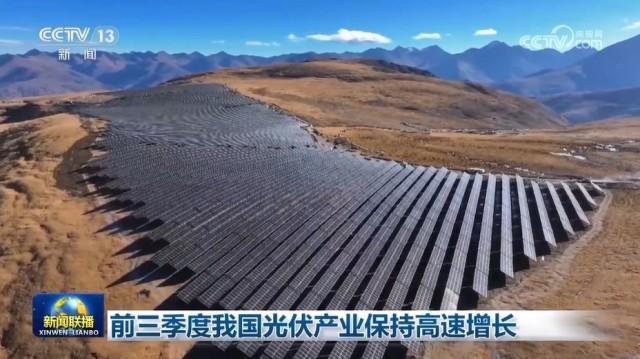According to the National Energy Administration website, on October 30th, Wang Dapeng, Deputy Director of the New Energy and Renewable Energy Department of the National Energy Administration, reported during a routine press conference that in the first three quarters of 2023, the national photovoltaic (PV) added capacity reached 12,894 megawatts, a year-on-year increase of 145%. This included 61.8 million kilowatts of centralized PV and 67.14 million kilowatts of distributed PV. As of the end of September 2023, the total PV installed capacity in the country reached 520 million kilowatts, with 295 million kilowatts from centralized PV and 225 million kilowatts from distributed PV. During the first three quarters of 2023, the national PV power generation amounted to 436.9 billion kilowatt-hours, showing a 33% year-on-year growth. The overall PV power generation utilization rate in the country reached 98.3%, an increase of 0.3 percentage points compared to the previous year.

In the first three quarters of this year, China’s photovoltaic (PV) market has continued to expand, with growth seen across various stages of the industry chain. The production in key segments of the PV industry has been consistently increasing, maintaining a high-speed growth trend.
In the past few days, the highest-altitude PV project in China, located in the Qinghai-Tibet Plateau, is intensively under construction. The project is using new PV inverters and other equipment for the first time in ultra-high-altitude areas, leading to a significant improvement in the photoelectric conversion rate.
During the first three quarters of this year, China’s investment in PV power generation reached 222.9 billion yuan, a year-on-year increase of 67.8%. More than half of the newly added installed capacity for power generation in the country comes from PV installations. China has now established the most complete PV industry chain globally, with production increases of over 70% in silicon materials, silicon wafers, cells, and modules during the same period. The total output value of the PV industry exceeded 1.2 trillion yuan. Breakthroughs continue in key core technologies, with the independently developed new crystalline silicon-perovskite tandem solar cells achieving a photoelectric conversion efficiency of 33.5%, reaching a world-leading level.
The China Electricity Council predicts that, with the implementation of policies such as green electricity trading and renewable energy quota systems, the PV industry in China will continue to develop rapidly. By the end of 2023, the grid-connected PV installed capacity is expected to reach 560 million kilowatts, accounting for nearly 20% of the total installed capacity.

Harnessing the Power of the Sun: The Role of Photovoltaic Power Generation in China’s Clean Energy Transition.
The remarkable expansion in photovoltaic (PV) market, marking a significant stride towards a cleaner and more sustainable energy landscape for China. This surge in PV power generation holds profound implications for the nation’s commitment to increasing the share of clean and low-carbon energy in its overall energy structure, It plays a key role in accelerating China’s achievement of carbon neutrality and peak carbon targets.
- Reducing Carbon Footprint:
The adoption and expansion of PV power generation play a pivotal role in reducing China’s carbon footprint. As a renewable energy source, solar power derived from PV systems produces electricity without emitting greenhouse gases, contributing to a substantial decrease in carbon emissions. With the nation grappling with environmental challenges, the widespread use of photovoltaic technology becomes a linchpin in the quest for a greener and more sustainable future.
- Diversifying Energy Sources:
Photovoltaic power generation provides a robust means of diversifying China’s energy mix. By relying on the inexhaustible power of the sun, the nation can decrease its dependence on traditional fossil fuels, such as coal and oil. This diversification not only enhances energy security but also insulates the country from the volatility of global energy markets. A diversified energy portfolio is a strategic step towards building resilience and sustainability in the face of evolving energy demands.
- Advancing Carbon Neutrality Goals:
China’s ambitious commitment to achieving carbon neutrality by 2060 necessitates aggressive measures to transition towards clean energy sources. The substantial growth in the PV market aligns seamlessly with this objective, as solar power becomes a linchpin in the nation’s decarbonization efforts. PV systems contribute to a more sustainable energy infrastructure, aligning with the broader strategy of mitigating climate change and safeguarding the environment for future generations.
- Meeting Peak Carbon Goals:
Beyond carbon neutrality, China is actively working towards peaking its carbon emissions before 2030. Photovoltaic power generation emerges as a key enabler in this endeavor. The scalability and versatility of PV systems make them integral in meeting the increasing energy demands while simultaneously reducing carbon emissions. The rapid deployment of solar technologies contributes to the acceleration of China’s journey towards achieving its peak carbon goals.
In conclusion, the burgeoning photovoltaic market in China signifies a paradigm shift towards a cleaner, greener, and more sustainable energy future. By harnessing the power of the sun, PV power generation becomes a cornerstone in the nation’s strategy to increase the proportion of clean and low-carbon energy in its energy structure. This not only contributes to the overarching goal of carbon neutrality by 2060 but also accelerates efforts to peak carbon emissions before 2030. As China continues to lead the way in renewable energy adoption, photovoltaic power generation stands out as a beacon of hope for a more environmentally conscious and resilient future.








